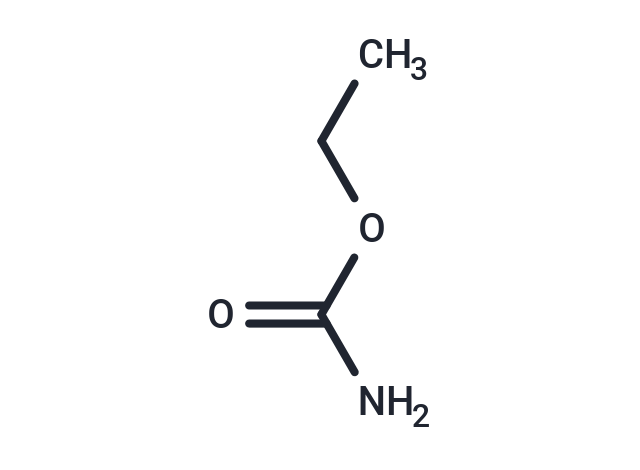Shopping Cart
Remove All Your shopping cart is currently empty
Your shopping cart is currently empty
Urethane (Ethyl carbamate; Ethylurethane) is a byproduct formed during the fermentation process of various foods. As an ethyl ester of carbamic acid, it has the ability to inhibit the growth of bacteria, sea urchin eggs, protozoa, and plant tissues, and is commonly used for establishing lung cancer models.

| Pack Size | Price | USA Warehouse | Global Warehouse | Quantity |
|---|---|---|---|---|
| 500 mg | $29 | - | In Stock | |
| 1 mL x 10 mM (in DMSO) | $29 | - | In Stock |
| Description | Urethane (Ethyl carbamate; Ethylurethane) is a byproduct formed during the fermentation process of various foods. As an ethyl ester of carbamic acid, it has the ability to inhibit the growth of bacteria, sea urchin eggs, protozoa, and plant tissues, and is commonly used for establishing lung cancer models. |
| Targets&IC50 | NMDAR:70 mM(EC50), GABAA receptor:64 mM(EC50), α4β2 nAChR:114 mM(EC50), AMPA receptor:34 mM(EC50), Glycine receptor:46 mM(EC50) |
| In vitro | urethane has a spectrum of action on ion channels, which is distinct from other anesthetics. It significantly potentiates the current responses of both GABAA and glycine receptors in a reversible and concentration-dependent manner. Conversely, urethane (10–300 mM) inhibits the responses of NMDA and AMPA receptors. Also, urethane potentiates the function of an nACh receptor and neuronal nicotinic acetylcholine, γ-aminobutyric acid A, and glycine receptors[3]. |
| In vivo | Urethane, a carcinogenic substance, is favored for acute in vivo electrophysiological experiments because it induces long-lasting steady level of anesthesia with muscle relaxation and minimally affects the autonomic and cardiovascular systems[2]. Urethane affects both inhibitory and excitatory systems but the magnitude of the alterations is less than that produced by other more selective anesthetics[3]. But also, Urethane anesthesia is usually restricted to terminal (acute) experiments due to its potential long-term toxicity[1]. |
| Synonyms | Ethylurethane, Ethyl carbamate, Carbamic acid ethyl ester |
| Molecular Weight | 89.09 |
| Formula | C3H7NO2 |
| Cas No. | 51-79-6 |
| Smiles | CCOC(N)=O |
| Relative Density. | 1.10 g/cm3 |
| Color | White |
| Appearance | Solid |
| Storage | keep away from moisture | Pure form: -20°C for 3 years | In solvent: -80°C for 1 year | Shipping with blue ice/Shipping at ambient temperature. | |||||||||||||||||||||||||||||||||||
| Solubility Information | DMSO: 55 mg/mL (617.35 mM), Sonication is recommended. | |||||||||||||||||||||||||||||||||||
| In Vivo Formulation | 10% DMSO+40% PEG300+5% Tween 80+45% Saline: 2 mg/mL (22.45 mM), Sonication is recommended. Please add the solvents sequentially, clarifying the solution as much as possible before adding the next one. Dissolve by heating and/or sonication if necessary. Working solution is recommended to be prepared and used immediately. The formulation provided above is for reference purposes only. In vivo formulations may vary and should be modified based on specific experimental conditions. | |||||||||||||||||||||||||||||||||||
Solution Preparation Table | ||||||||||||||||||||||||||||||||||||
DMSO
| ||||||||||||||||||||||||||||||||||||
| Size | Quantity | Unit Price | Amount | Operation |
|---|

Copyright © 2015-2025 TargetMol Chemicals Inc. All Rights Reserved.